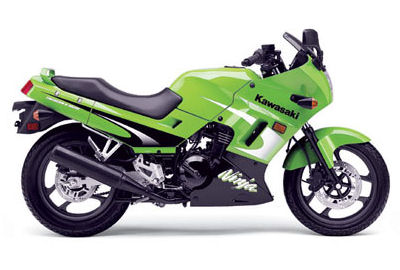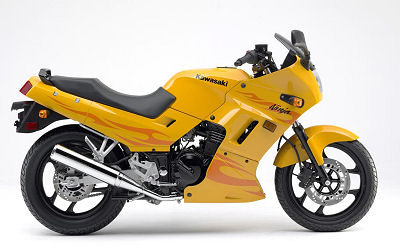3rd Generation - 1988-2007
The 3rd generation of the 250 Ninja (sometimes called the "classic" 250 Ninja) is superficially similar to the 2nd generation model, though few of the parts are actually interchangeable.
The 3rd generation model is a water cooled parallel twin, using a double overhead cam arrangement and 4 valves per cylinder. The fairings are a little more complete than the 2nd generation model. Wheels are still 16" and the engine had a 14,000 rpm rev limit (later reduced to 13,000 for better reliability).

2003 Kawasaki 250 Ninja EX250F
Peak power of the 3rd generation 250 Ninja is given as 37.4 bhp at 12,500 rpm at the crank. Measured rear wheel hp is usually around 28 bhp for a well tuned bike in good condition. 0-60mph times of under 6 seconds have been reported, with a 14.6 second 1/4 mile time. True top speed is a little over 100 mph, maybe up to 105 mph on the best tuned bikes, depending somewhat on conditions, the weight and size of the rider and how well the rider tucks in [note: the stock speedometer reads a little high, so optimistic claims much over 100 mph are probably being read off the speedometer, not a GPS speed readout].
The bike remained essentially unchanged throughout its production run, though some small changes were made in 1994 which included using a harder material for the cylinder head and some slight modifications to the electrical system. However 98% of the parts are interchangeable between the first 1988 models and the last 2007 models, and those that aren't directly interchangeable can usually be used with slight modifications.
Though no mechanical changes were made, the red line was lowered from 14,000 rpm to 13,000 rpm in 2005. This was due to Kawasaki becoming more conservative and realizing that there could be some lubrication problems over 13,000 rpm. Early models (1988-1995) has an ignition limiter set to 15,500 rpm. This dropped to 14,500 rpm between 1996 and 2005, and to 14,000 rpm in 2006 and 2007. Again, no changes to the engine, just a decision to lower the maximum rpm to increase engine reliability.

2006 Kawasaki 250 Ninja EX250F
Gas mileage can vary anywhere from around 45 mpg with aggressive city riding to maybe 75 mpg with relaxed interstate cruising at or below the speed limit. Most riders get an average of somewhere around 60 mpg. Fuel tank capacity is 4.8 gallons, giving a comfortable range of around 250 miles between fill-ups. Using extraordinary measures (coasting, barely accelerating, 6th gear whenever possible, sprocket gearing changes, no speeding) users have reported getting in excess of 100 mpg (US gallon of course), but you won't see anything like that in normal use.
The third generation 250 Ninja is an ideal bike for both beginners and experienced riders. Used bikes in running condition can be found from around $800 to around $2000 so they are quite affordable. Candidates for restoration can be found for a few hundred dollars. Since it's "only" 250cc (249cc to be exact) insurance is generally fairly cheap (unless you are 16). There are lots of used parts available and the bike is easy to work on. Its light weight and agile handling means that - with a good rider - it can keep up with much larger bikes pretty much anywhere except for drag races and extra-legal speeds on the highway.